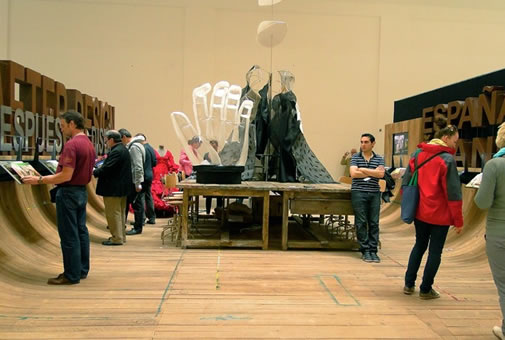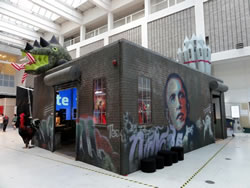News & Notices
The View from Prague

The Spanish exhibit in the Countries and Regions Section of the Prague Quadrennial of Performance Design & Space was both a striking visual display as well as a stage for an extreme costume project.
Photos/Alexandra Bonds
This is the first in a series of articles reporting on the 2011 Prague Quadrennial of Performance Design and Space which was held June 16 to 26.
The 2011 Prague Quadrennial of Performance Design and Space opened in the element of fire, a reflection of the motivation for the new location of the exhibits, after a fire destroyed the left wing of the former home in the Industrial Palace. After a brief volley of fireworks, the massive metal doors of the Veletrzni Palace slowly came apart releasing billowing smoke onto the awaiting crowd attending the gala event. As the cloud dispersed, the displays for the Countries and Regions Section in the Grand Exhibit Hall were revealed, each evoking a unique insight into theatre design.
Three more openings followed each hour in a different part of the city. The Intersection Project at the Piazzetta invited viewers to enter the maze of white boxes filled with performances, installations, and artistic dialogue. Students attending Scenofest gathered at the Theatre Academy to hear warm welcoming words from Jessica Bowles followed by a concert. The Architecture Section invited visitors by simply opening of a door into the beautiful, originally gothic, inner space of St. Anne’s church.
A walk through the section of Regions and Countries proved that even in a constantly shrinking world of global communication, there are still inspiring distinctions and amazing ideas deeply rooted in the national environments. The thought-provoking exhibits demonstrated that sharing the different views and opinions about performance is vitally important for the future development of theatre making.
Each exhibit was a unique expression of the performance art of that country. The Israeli exhibit, consisting of towering shelves of condom boxes, focused on the works of a single playwright/director, Hanoch Levin, recently deceased, whose play, The Condom Merchant, reflected the promiscuity and politics of that country in the 1970s. Similarly, the Hungarian exhibit featured works of a single artist, Mihaly W. Bodza, whose recent disappearance, shrouded in mystery, prompted the serious tone in which his scenographic works were portrayed.
Romania’s stand reflected on art as sacrifice with a cross of light on the exhibit wall and the productions displayed as reflections in broken down buckets, inspired by Romanian belief that to build a church and dig a well are two most noble and generous deeds. Sacrifice here is understood as the instrument of creation. Iceland’s serene and meditative living room, an installation in all white, changed and morphed daily through performance and interaction with the audience.
Another installation that challenged the viewer to think about objects in space, but this time without interaction, was the Norwegian’s electromechanical Telling Orchestra. The objects, animated by an unseen computer operator, created a soundscape in front of projections. Perhaps the most multifaceted and visually striking was the Spanish exhibit. The wooden arc, in the shape a boat or a scale, represented the search for balance between the new era, craft, and dreams. The space was dominated by long, heavy worktable and sculptures of hands representing the crafts workers who execute the designer’s ideas. It also became a stage for a performance of Maria Elena Rogue’s extreme costume project, Moon Woman, that was made out of slowly disappearing cookies eaten by visitors.
 Amidst these varied displays was the USITT USA exhibit, a recreated performance garage, defaced with graffiti, including the iconic image of Barack Obama created by Shepard Fairey. With a focus on social commentary, the exhibit told the story of the dominant issues facing Americans today, from racial tensions and war to religious conservatism and ecology. The productions were mounted on sawhorses and ladders, as well as projected onto the walls creating a notable contrast between low and high technology. Gallery talks and interviews with the production teams engendered dialogs about the future of ensemble theatre, media and design, and re-imagining the definition of theatre.
Amidst these varied displays was the USITT USA exhibit, a recreated performance garage, defaced with graffiti, including the iconic image of Barack Obama created by Shepard Fairey. With a focus on social commentary, the exhibit told the story of the dominant issues facing Americans today, from racial tensions and war to religious conservatism and ecology. The productions were mounted on sawhorses and ladders, as well as projected onto the walls creating a notable contrast between low and high technology. Gallery talks and interviews with the production teams engendered dialogs about the future of ensemble theatre, media and design, and re-imagining the definition of theatre.
Viewers’ responses to the exhibit were enthusiastic, noting the strength of the theme, the innovation of the production designs, and appreciation for the performing artists, Paul Zaloom and his Toy Theatre and Pat Olezko’s See/Change and Greenpiece: Walking, Squawking Topiary. Special kudos were mentioned for the team of faculty and students from The University of Montana for their skill and artistry in creating the exhibit.

